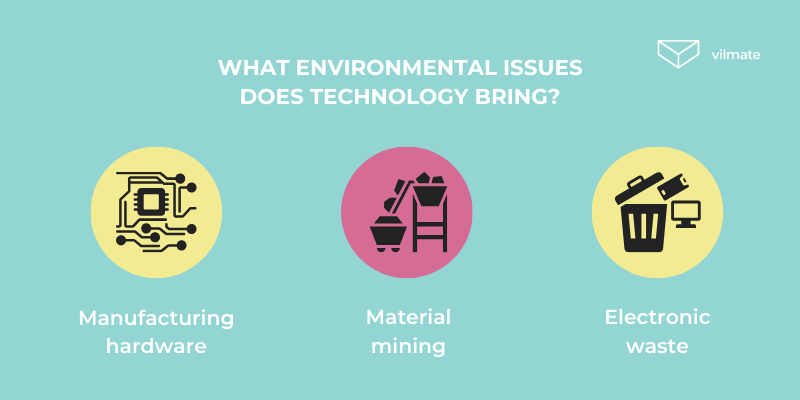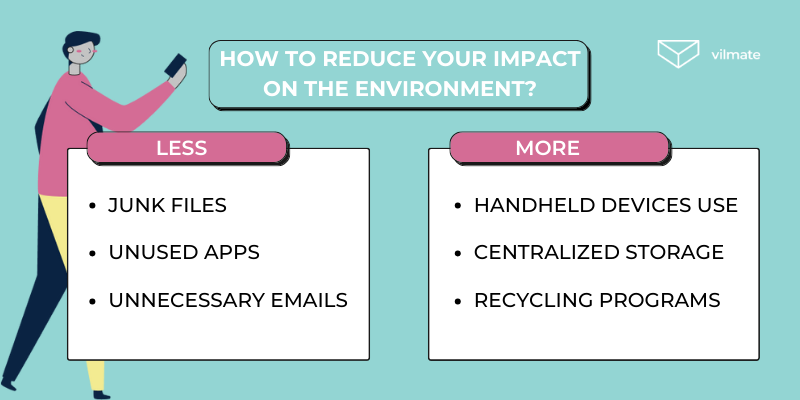Humanity has long disregarded the environment, and this apathy is starting to cause serious global problems. Nowadays, people take ecological issues seriously and understand that almost everything we do somehow harms nature.
Urbanization, industrial growth, and excessive energy use have led not only to technological advancements but to big ecological issues as well. Even relatively modern fields like IT are harming the environment significantly.
Today, we'll discuss how information technology affects the environment and what we can do about it. We'll explain the concept of Green IT and offer practical advice on how we can help improve the situation.
How IT impacts the environment
At times, it may seem like our online activities exist separately from the physical world. When we use the internet, it feels like we're entering a different realm that couldn't harm our surroundings. However, this belief is mistaken.
The main issue stemming from our digital habits is our carbon footprint. Research from 2019 shows that digital technologies contributed to about 4% of greenhouse gas emissions, which is comparable to the environmental effects of the aviation industry.
Additionally, information technology operations consume plenty of electricity, and this consumption is increasing every year. The reason is that every time we go online or use apps on our devices, data is sent back and forth to servers. These servers, essentially large computers, operate continuously to provide us access to websites and applications.
A significant amount of electricity is required to keep servers running smoothly, as they operate nonstop and need cooling to prevent constant overheating.
Each time we upload photos, watch videos, or send messages online, we add to the data stored and transmitted across the network. The more data there is, the more energy it takes to process and store it.
While a single action might not seem like a big deal, it adds up quickly when millions of people do the same thing at once, leading to a spike in energy consumption. Between 2013 and 2020, electricity usage in IT shot up by 70%, and now it's increasing by 9% annually.
But why does this power consumption harm the environment so much?
The issue is that many data centers rely on electricity generated from non-renewable sources such as coal, oil, and natural gas. These energy sources are major sources of greenhouse gas emissions and other pollutants, worsening air quality and speeding up climate change.
Moreover, the extraction and utilization of fossil fuels have adverse effects on the environment in various ways. These harms can include damaging landscapes during coal or oil extraction, polluting water and land ecosystems, and negatively affecting human and animal well-being due to the release of toxic substances.
What other environmental issues does technology bring?
- Manufacturing hardware. Making computers, smartphones, servers, and other gadgets requires resources and energy. From mining for raw materials like ores and oil to making tiny parts like microchips and circuit boards, every step harms the environment by polluting water and air, releasing toxic chemicals, and cutting down forests.
- Material mining. To make computers and other gadgets, we need rare metals like lithium and cobalt, which are often mined in ways that harm the environment. Mining can mean chopping down forests, polluting soil and water, and disrupting ecosystems.
- Electronic waste. While technology gets updated so fast, we consume tons of electronic junk. Old or broken gadgets often get thrown in the trash, which pollutes soil and water with toxic decomposing materials.

Sure, some tech these days helps the environment, like artificial intelligence. But right now, the harm technology does is way worse than any help it gives. That's why we'll now talk about making things better - Green IT.
Why IT has to become greener
Green IT is all about using information technology in a way that's good for the environment. The main goal is to ensure that the computers, servers, and other tech equipment we use are energy-efficient, eco-friendly, and use resources reasonably.
Green IT involves several common practices:
- Using energy-efficient technologies, such as computers, software, and other tech that don't over consume energy, and finding ways to optimize the energy flow while performing tasks.
- Lowering carbon emissions is crucial to protect the environment. United Nations recommends a 7.6% annual reduction for the next decade to halt global warming.
- Extend the life of tech by reusing and recycling parts to create new products rather than discarding everything.
- When disposing of old electronics in an environmentally friendly way to avoid dumping toxic materials into the soil or water.
- Switching to renewable energy sources such as solar and wind power to replace fossil fuels.
- Sharing knowledge with people about the importance of using technology in an eco-friendly way.
- Products should be designed to be more eco-friendly, long-lasting, easy to fix, use environmentally friendly materials, and provide recyclable packaging.
As the influence of IT on the environment goes up and the necessity to decrease greenhouse gas emissions and utilize limited natural resources becomes more apparent, Green IT is gaining prominence for businesses and society as a whole.
But how can Green IT be implemented in reality? Meaningful progress can be achieved if large and small corporations, governments, and individual users act as one.
What do we do to reduce the environmental impact of IT?
In recent years, environmental sustainability in the IT sector has gained significant attention. Some major players, like Apple, Google, and Meta, are leading the way by powering their data centers with 100% renewable energy.
Let's take a closer look at Apple's efforts as an example of positive trends in production:
- Creating carbon-neutral products. Apple has introduced carbon-neutral products, starting with the Apple Watch, and aims to make all its products carbon-neutral by 2030.
- Reducing emissions. Apple is significantly reducing its emissions by using environmentally friendly electricity and adopting low-carbon delivery methods.
- Product recycling. In 2022 alone, Apple recycled 40,000 metric tons of electronic waste. Now, 20% of the materials used in their products are recycled.
- Decreasing consumption. Apple's decision to exclude headphones and power adapters from iPhone boxes, while initially met with resistance from users, has led to reduced accessory production and smaller packaging sizes. This approach means more Apple products can be transported in cargo shipments, reducing fuel consumption and vehicle emissions.
Despite some companies' growing awareness and efforts, many tech giants, like Amazon, have yet to commit to similar environmentally friendly practices in their operations.
It's also crucial for governments to take Green IT seriously and implement measures to protect the environment. Here are some example of reasonable actions taking place in the civilized world:
- Setting rules and standards. Governments establish rules for energy-efficient IT products and waste management. They also pass laws to encourage the use of renewable energy.
- Financial help. Governments finance companies trying to be greener. This help could be in subsidies or tax breaks for using eco-friendly technology.
- Spreading awareness. Governments can explain and teach people about Green IT via campaigns, grants, and specialized programs. They can help businesses and society understand why it's in our own interest to be eco-friendly.
- Working together. Governments help different groups, such as businesses, schools, and community organizations, collaborate on Green IT projects.
- Sharing best practices. Governments can create platforms where companies share their experiences with Green IT.
- Building better infrastructure. Governments can invest in infrastructure for Green IT, like solar panels or optimized data centers that use energy-efficient approaches.
These steps can create a better environment for Green IT to grow and help move towards a more sustainable economy.
Both big companies and governments can make a big difference in updating information technology. But what about regular people?
Research from the British company OVO Energy shows that by sending one less email daily, UK people could reduce carbon dioxide emissions by 16,433 tons.
Another study by the Shift Project found that streaming videos contribute to 300 million tons of carbon emissions every year. That's as much as the yearly emissions of a big country like Spain. So, by skipping just one episode on Netflix, you're already helping the environment.
But what else can you do to reduce your impact on the environment? Here are some ideas:
- Clean up your files. Regularly delete unnecessary files and photos from your cloud storage. Less data means less energy used on the servers storing it.
- Get rid of unused apps. Deleting apps you no longer use can lighten the load on your device and reduce the amount of data it processes, cutting down its energy consumption.
- Use your phone more. Whenever possible, use your mobile device instead of a computer for simple tasks like reading documents or sending emails. Mobile devices typically use less energy than computers.
- Unsubscribe from unnecessary emails. Think about which email subscriptions and mailing lists you need, and unsubscribe from the ones you don't read or use anymore. This reduces the volume of incoming emails, saves energy used for email processing on servers, and reduces carbon emissions.
- Choose Google services. Google operates energy-efficient data centers and supports renewable energy. Storing information in Google Drive or Google Photos is environmentally friendly.
- Support recycling. Properly dispose of old equipment and electronic devices to avoid pollution and promote material reuse. Many companies offer recycling programs for old technology.

In addition to supporting eco-friendly practices, you can raise awareness about Green IT and encourage others to do the same.
A few tips for greener office management
Despite the rise of remote practices, physical spaces still play a significant role in working operations. Here are three practical tips for managing your office that could help contribute to environmental conservation:
- Host educational events. Arrange workshops and seminars on environmental sustainability at work. Invite guest speakers or experts to discuss topics like saving energy, reducing waste, recycling, and the benefits of eco-friendly practices. Information and resources can raise awareness and encourage your colleagues to adopt greener habits.
- Adopt green policies. Introduce eco-friendly initiatives and policies in your office. This step might include setting up recycling stations, promoting reusable items like coffee cups and water bottles, and encouraging energy-saving practices such as turning off lights and electronics when not in use.
- Lead by example. Show leadership in promoting environmental awareness. Participate actively in green initiatives, consistently follow eco-friendly practices, and openly support sustainability efforts. Encourage your colleagues to join you in ecological activities, such as community clean-up events or volunteering for green projects.
Remember, adopting just one of these tips might not make a big difference. However, by incorporating Green IT practices into all aspects of your work, you can contribute more to environmental conservation than you might realize!
Final reflections
Taking care of the environment means taking care of our future and the future of generations to come. Preserving our planet is crucial because there are no viable alternatives in the foreseeable future.
At Vilmate, we are committed to Green IT practices. Partnering with us means you can be sure that your projects will have a minimum impact on our nature and the surrounding world. Contact us to bring your big and complex or small but ambitious projects to life!




